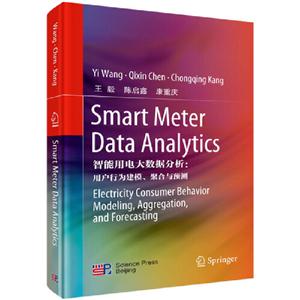智能用电大数据分析:用户行为建模.聚合与预测(英文版)
内容简介
[
本书旨在充分利用所有可获取的数据,并将其转化为实际信息,并将其纳入电力用户行为建模和配用电系统运行中。本书首先概述了智能电表数据分析的近期新发展。由于数据管理是进一步智能电表数据分析及其应用的基础,因此随后研究了数据管理的三个问题,即数据压缩、异常检测和数据生成。接下面的工作试图模拟复杂的电力用户行为。具体工作包括负荷分析、模式识别、个性化价格设计、社会人口信息识别和家庭行为编码。在此基础上,本书在时空尺度上扩展了消费者行为。介绍了用户聚合、单个负载预测和聚合负载预测等工作。我们希望这本书能够启发读者去定义新的问题,应用新的方法,并通过大量的智能电表数据,甚至电力系统中的其他监测数据,获得一些有意思的结论。
]
目录
Contents1 Overview of Smart Meter Data Analytics 11.1 Introduction 11.2 Load Analysis 41.2.1 Bad Data Detection 51.2.2 Energy Theft Detection 61.2.3 Load Profiling 81.2.4 Remarks 91.3 Load Forecasting 111.3.1 Forecasting Without Smart Meter Data 111.3.2 Forecasting with Smart Meter Data 141.3.3 Probabilistic Forecasting 161.3.4 Remarks 181.4 Load Management 191.4.1 Consumer Characterization 191.4.2 Demand Response Program Marketing 211.4.3 Demand Response Implementation 221.4.4 Remarks 231.5 Miscellanies 251.5.1 Connection Verification 251.5.2 Outage Management 261.5.3 Data Compression 261.5.4 Data Privacy 271.6 Conclusions 28References 282 Electricity Consumer Behavior Model 372.1 Introduction 372.2 Basic Concept of ECBM 392.2.1 Definition 392.2.2 Connotation 412.2.3 Denotation 422.2.4 Relationship with Other Models 432.3 Basic Characteristics of Electricity Consumer Behavior 452.4 Mathematical Expression of ECBM 472.5 Research Paradigm of ECBM 502.6 Research Framework of ECBM 512.7 Conclusions 57References 573 Smart Meter Data Compression 593.1 Introduction 593.2 Household Load Profile Characteristics 613.2.1 Small Consecutive Value Difference 613.2.2 Generalized Extreme Value Distribution 623.2.3 Effects on Load Data Compression 643.3 Feature-Based Load Data Compression 663.3.1 Distribution Fit 663.3.2 Load State Identification 673.3.3 Base State Discretization 673.3.4 Event Detection 683.3.5 Event Clustering 693.3.6 Load Data Compression and Reconstruction 693.4 Data Compression Performance Evaluation 713.4.1 Related Data Formats 713.4.2 Evaluation Index 723.4.3 Dataset 723.4.4 Compression Efficiency Evaluation Results 733.4.5 Reconstruction Precision Evaluation Results 743.4.6 Performance Map 743.5 Conclusions 77References 774 Electricity Theft Detection 794.1 Introduction 794.2 Problem Statement 814.2.1 Observer Meters 814.2.2 False Data Injection 814.2.3 A State-Based Method of Correlation 834.3 Methodology and Detection Framework 834.3.1 Maximum Information Coefficient 844.3.2 CFSFDP-Based Unsupervised Detection 854.3.3 Combined Detecting Framework 864.4 Numerical Experiments 884.4.1 Dataset 884.4.2 Comparisons and Evaluation Criteria 894.4.3 Numerical Results 904.4.4 Sensitivity Analysis 934.5 Conclusions 97References 975 Residential Load Data Generation 995.1 Introduction 995.2 Model 1015.2.1 Basic Framework 1015.2.2 General Network Architecture 1025.2.3 Unclassified Generative Models 1065.2.4 Classified Generative Models 1105.3 Methodology 1135.3.1 Data Preprocessing 1145.3.2 Model Training 1155.3.3 Metrics 1185.4 Case Studies 1225.4.1 Data Description 1225.4.2 Unclassified Generation 1235.4.3 Classified Generation 1255.5 Conclusion 134References 1346 Partial Usage Pattern Extraction 1376.1 Introduction 1376.2 Non-negative K-SVD-Based Sparse Coding 1396.2.1 The Idea of Sparse Representation 1396.2.2 The Non-negative K-SVD Algorithm 1406.3 Load Profile Classification 1416.3.1 The Linear SVM 1416.3.2 Parameter Selection 1426.4 Evaluation Criteria and Comparisons 1436.4.1 Data Compression-Based Criteria 1436.4.2 Classification-Based Criteria 1446.4.3 Comparisons 1456.5 Numerical Experiments 1466.5.1 Description of the Dataset 1466.5.2 Experimental Results 1476.5.3 Comparative Analysis 1526.6 Further Multi-dimensional Analysis 1546.6.1 Characteristics of Residential & SME Users 1546.6.2 Seasonal and Weekly Behaviors Analysis 1566.6.3 Working Day and Off Day Patterns Analysis 1586.6.4 Entropy Analysis 1596.6.5 Distribution Analysis 1606.7 Conclusions 161References 1617 Personalized Retail Price Design 1637.1 Introduction 1637.2 Problem Formulation 1657.2.1 Problem Statement 1657.2.2 Consumer Problem 1667.2.3 Compatible Incentive Design 1667.2.4 Retailer Problem 1677.2.5 Data-Driven Clustering and PreferenceDiscovering 1687.2.6 Integrated Model 1717.3 Solution Methods 1727.3.1 Framework 1727.3.2 Piece-Wise Linear Approximation 1727.3.3 Eliminating Binary Variable Product 1737.3.4 CVaR 1737.3.5 Eliminating Absolute Values 1747.4 Case Study 1747.4.1 Data Description and Experiment Setup 1747.4.2 Basic Results 1757.4.3 Sensitivity Analysis 1787.5 Conclusions and Future Works 183Appendix I 183Appendix II 184References 1858 Socio-demographic Information Identification 1878.1 Introduction 1878.2 Problem Definition 1898.3 Method 1908.3.1 Why Use a CNN? 1908.3.2 Proposed Network Structure 1918.3.3 Description of the Layers 19
封面

书名:智能用电大数据分析:用户行为建模.聚合与预测(英文版)
作者:,陈启鑫,康重庆
页数:316
定价:¥198.0
出版社:科学出版社
出版日期:2020-05-01
ISBN:9787030647313
PDF电子书大小:56MB 高清扫描完整版
